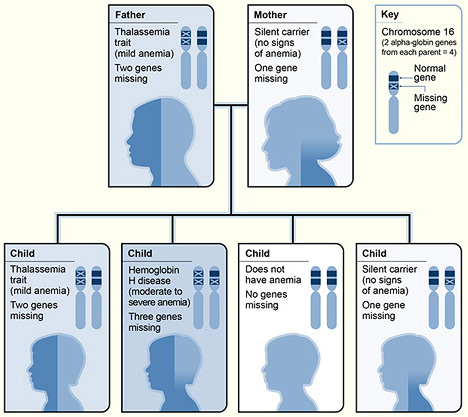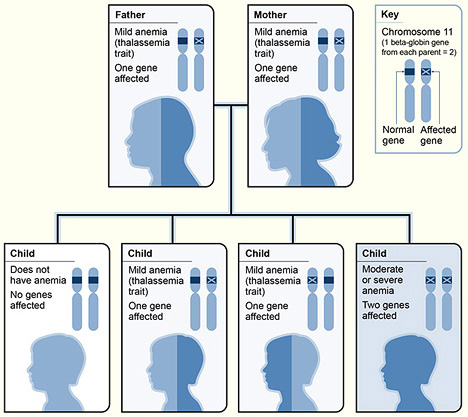What Causes Thalassemias?
Your body makes three types of blood cells: red
blood cells, white blood cells, and platelets (PLATE-lets). Red blood cells
contain hemoglobin, an iron-rich protein that carries oxygen from your lungs to
all parts of your body. Hemoglobin also carries carbon dioxide (a waste gas)
from your body to your lungs to be exhaled.
Hemoglobin has two kinds of protein
chains: alpha globin and beta globin. If your body doesn't make enough of
these protein chains, red blood cells don't form properly and can't carry
enough oxygen. Your body won't work well if your red blood cells don't make
enough healthy hemoglobin.
Genes control how the body makes hemoglobin protein
chains. When these genes are missing or altered, thalassemias occur.
Thalassemias are inherited disorders. That is,
they're passed on from parents to their children through genes. People who get
abnormal hemoglobin genes from one parent but normal genes from the other are
called carriers. Carriers often have no signs of illness other than mild
anemia.
However, they can pass the abnormal genes on to their children.
People with moderate to severe forms of thalassemia
have inherited abnormal genes from both parents.
Alpha Thalassemias
Four genes (two from each parent) are needed to make
enough alpha globin protein chains. If one or more of the genes is missing, you
will have alpha thalassemia trait or disease. This means that you don't make
enough alpha globin protein.
- If you have only one missing gene, you're a
silent carrier and won't have any signs of illness.
- If you have two missing genes, you have alpha
thalassemia trait (also called alpha thalassemia minor). You may have mild
anemia.
- If you have three missing genes, you likely will
have hemoglobin H disease (which a
blood
test can detect). This form of thalassemia causes moderate to severe
anemia.
Very rarely, a baby will have all four genes
missing. This condition is called alpha thalassemia major or hydrops fetalis.
Babies with hydrops fetalis usually die before or shortly after birth.
Inheritance Pattern for Alpha
Thalassemia

The diagram shows one example of how
alpha thalassemia is inherited. The alpha globin genes are located on
chromosome 16. A child inherits four alpha globin genes—two from each
parent. In this example, the father is missing two alpha globin genes and the
mother is missing one alpha globin gene.
Therefore, each child has a 25
percent chance of inheriting two missing genes and two normal genes
(thalassemia trait), three missing genes and one normal gene (hemoglobin H
disease), four normal genes (no anemia), or one missing gene and three normal
genes (silent carrier).
Beta Thalassemias
Two genes (one from each parent) are needed to make
enough beta globin protein chains. If one or both of these genes are altered,
you will have beta thalassemia. This means that you don't make enough beta
globin protein.
- If you have one altered gene, you're a carrier.
This condition is called beta thalassemia trait or beta thalassemia minor. It
causes mild anemia.
- If both genes are altered, you will have beta
thalassemia intermedia or beta thalassemia major (also called Cooley's anemia).
The intermedia form of the disorder causes moderate anemia. The major form
causes severe anemia.
Inheritance Pattern for Beta
Thalassemia

The diagram shows one example of how
beta thalassemia is inherited. The beta globin gene is located on chromosome
11. A child inherits two beta globin genes—one from each parent. In this
example, each parent has one altered beta globin gene.
Therefore, each child has a 25
percent chance of inheriting two normal genes (no anemia), a 50 percent chance
of inheriting one altered gene and one normal gene (beta thalassemia trait), or
a 25 percent chance of inheriting two altered genes (beta thalassemia
major). |

